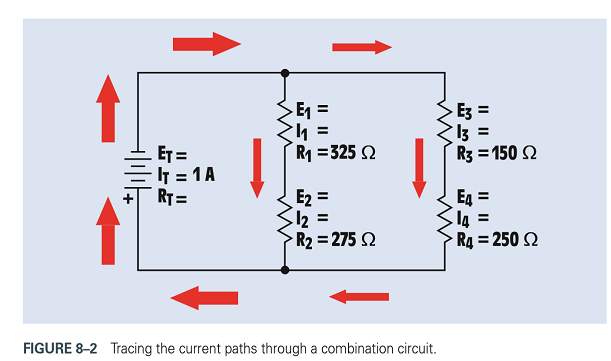
Concept explainers
Refer to the circuit shown in Figure 8-2. Redraw the circuit and use the following values:
Assume that an ammeter indicates a total circuit current of 15 mA.
A voltmeter indicates the following voltage drops across each resistor:
What is the most likely problem with this circuit?

Trending nowThis is a popular solution!

Chapter 8 Solutions
Delmar's Standard Textbook of Electricity (MindTap Course List)
- Solve the octic polynomial 2s⁸+s⁷+2s⁶-31s⁴-16s³-32s²-160=0 Only expert should attempt this question,no artificial intelligencearrow_forwardFour isotropic point sources placed along z-axis as shown. Assuming the current coefficient of element 1 and 2 is 1, while of 3 and 4 is -1. Derive array factor, then find null directions (d=2/2) d/2 di2 #4arrow_forwardExplain the operation of the circuit if M contacts 2 and 3 do not close.arrow_forward
- Q5: Given the following system: น -3 y= [4 -2] +3u Generate a model with states that are the sum and difference of the original states.arrow_forwardFind the state transition matrix. for the system whose simulation diagram is shown below: Uz x2 K 3 K=16arrow_forwardQ3: Find the state-space representation for the system given by:- + 16 + ၃- တိုင်း၍ရား +arrow_forward
- No chatgpt pls will upvote Already got wrong chatgpt answerarrow_forward"I need an expert solution with detailed steps for integration." The normalized Far-field pattern of an antenna is given by: E = √√sine (cosq) Determine: 1) Beam solid angle 2) Exact Directivity 0≤0≤ 180, while 0≤≤180, and 270 ≤≤ 360 3) HPBW in both azimuth and elevationarrow_forward"I need an expert solution with detailed steps for integration." Find Directivity, the effect aperture and aperture efficiency of the antenna, if it has physical aperture of 2.4 x 10-2-2 and the radiation intensity can be approximated by: U(0, 4) = (sesce 0°s0<20° 20°ses600 1.0°≤≤ 360°arrow_forward
- Don't use ai to answer I will report you answerarrow_forwardDon't use ai to answer I will report you answerarrow_forward"Can you explain the integration method to show the result?" The radiation intensity of an aperture antenna, mounted on an infinite ground plane with perpendicular to the aperture, is rotationally symmetric (not a function of 4), and it is given by U = π sin Find the approximate directivity (dimensionless and in dB) using (a) numerical integration. Use the DIRECTIVITY computer program at the end of this chapter. U sin ( sin ) sin (a) Directly Do = 14.0707 = 10log (14.0707) = 11.48 dBarrow_forward
 Delmar's Standard Textbook Of ElectricityElectrical EngineeringISBN:9781337900348Author:Stephen L. HermanPublisher:Cengage Learning
Delmar's Standard Textbook Of ElectricityElectrical EngineeringISBN:9781337900348Author:Stephen L. HermanPublisher:Cengage Learning Electricity for Refrigeration, Heating, and Air C...Mechanical EngineeringISBN:9781337399128Author:Russell E. SmithPublisher:Cengage Learning
Electricity for Refrigeration, Heating, and Air C...Mechanical EngineeringISBN:9781337399128Author:Russell E. SmithPublisher:Cengage Learning

